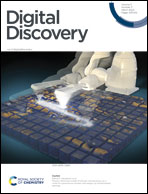Derivative-based pre-training of graph neural networks for materials property predictions†
Abstract
While pre-training has transformed many fields in deep learning tremendously, its application to three-dimensional crystal structures and materials science remains limited and under-explored. In particular, devising a general pre-training objective which is transferable to many potential downstream tasks remains challenging. In this paper, we demonstrate the benefits of pre-training graph neural networks (GNNs) with the objective of implicitly learning an approximate force field via denoising, or explicitly via supervised learning on energy, force, or stress labels. For implicit learning of the force field, we find there are significant benefits to training the model on the derivatives of the output, rather than on the output itself. We further show an explicit training of the force field using labelled data yields an even greater benefit than implicit training, and similarly benefits from a derivative-based training objective. We find that overall, the best pre-training performance can be achieved by explicitly learning the full combination of energy, force, and stress labels using output derivatives. This pre-training approach is advantageous as it leverages readily available forces from non-equilibrium structures produced during ab initio calculations, enabling the usage of significantly larger datasets for pre-training than using only equilibrium structures in denoising. We demonstrate the effectiveness of this approach on a wide range of materials property benchmarks across many materials systems and properties. These results suggest exciting future opportunities for scaling up pre-training on GNNs to build foundational models in materials science.



 Please wait while we load your content...
Please wait while we load your content...